Homework • Chapters 10 and 11



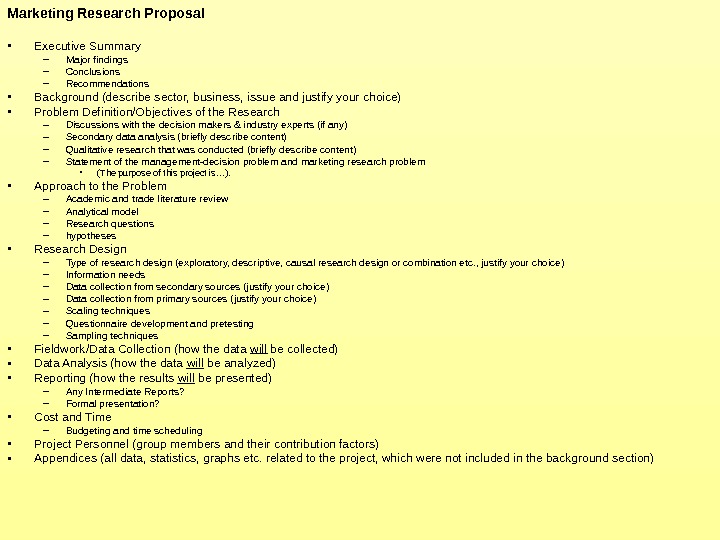








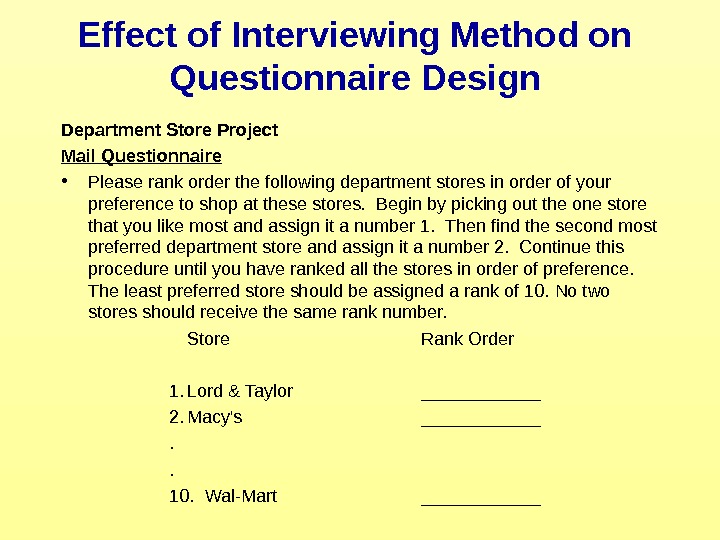















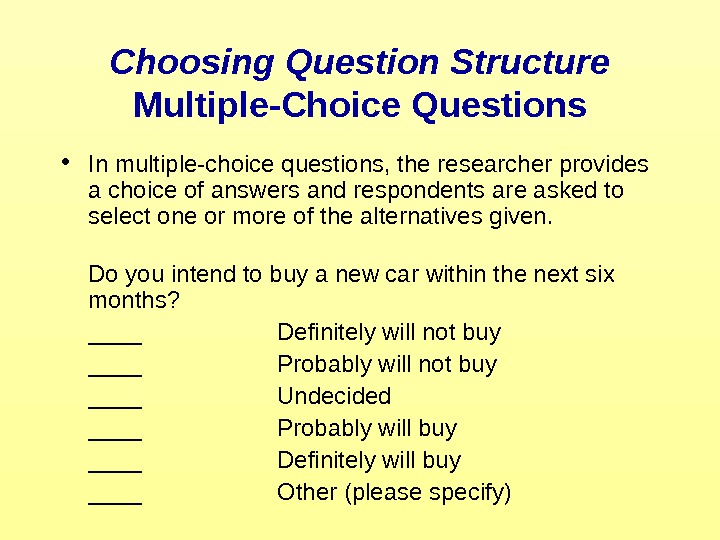



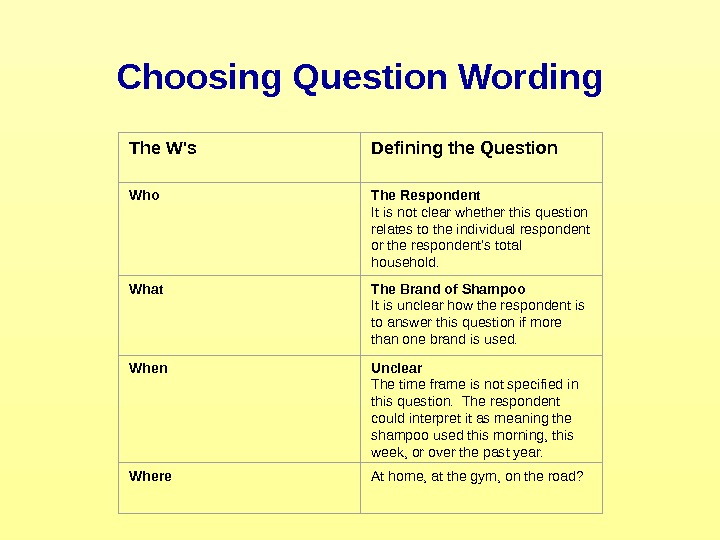
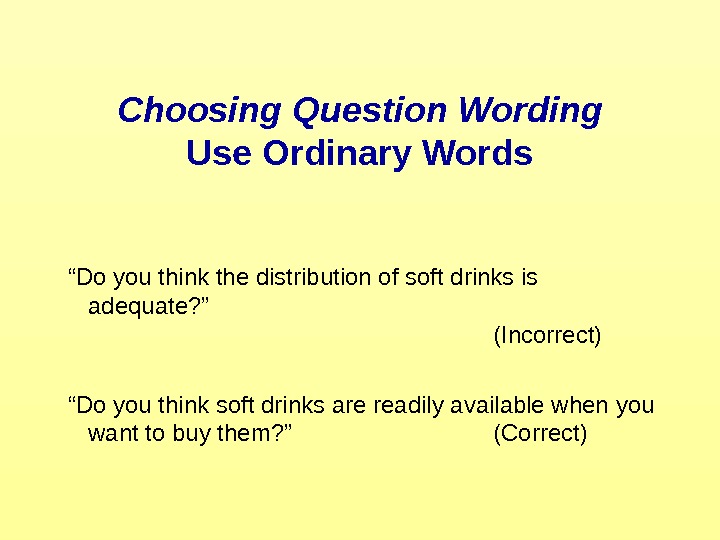
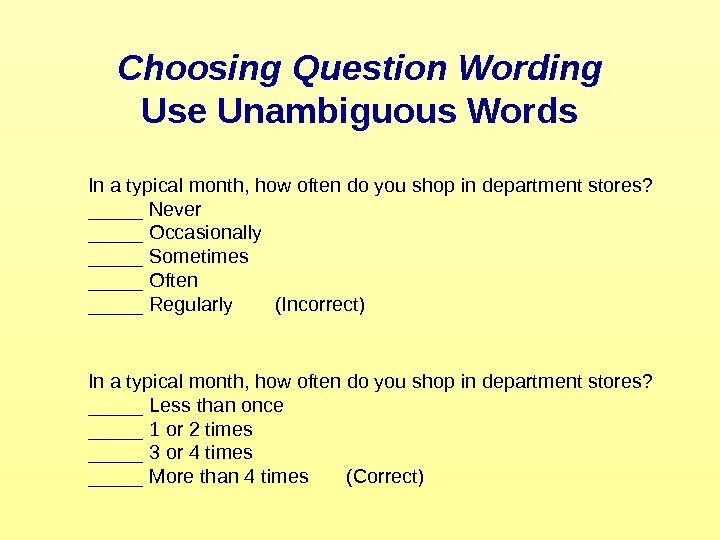























- Размер: 239 Кб
- Количество слайдов: 57
Описание презентации Homework • Chapters 10 and 11 по слайдам

 Homework • Chapters 10 and 11 • In class test (Quiz 5, Chapters 9 and 10)
Homework • Chapters 10 and 11 • In class test (Quiz 5, Chapters 9 and 10)
 Marketing Research Proposal • Executive Summary – Major findings – Conclusions – Recommendations • Background (describe sector, business, issue and justify your choice) • Problem Definition/Objectives of the Research – Discussions with the decision makers & industry experts (if any) – Secondary data analysis (briefly describe content) – Qualitative research that was conducted (briefly describe content) – Statement of the management-decision problem and marketing research problem • (The purpose of this project is…). • Approach to the Problem – Academic and trade literature review – Analytical model – Research questions – hypotheses • Research Design – Type of research design (exploratory, descriptive, causal research design or combination etc. , justify your choice) – Information needs – Data collection from secondary sources (justify your choice) – Data collection from primary sources (justify your choice) – Scaling techniques – Questionnaire development and pretesting – Sampling techniques • Fieldwork/Data Collection (how the data will be collected) • Data Analysis (how the data will be analyzed) • Reporting (how the results will be presented) – Any Intermediate Reports? – Formal presentation? • Cost and Time – Budgeting and time scheduling • Project Personnel (group members and their contribution factors) • Appendices (all data, statistics, graphs etc. related to the project, which were not included in the background section)
Marketing Research Proposal • Executive Summary – Major findings – Conclusions – Recommendations • Background (describe sector, business, issue and justify your choice) • Problem Definition/Objectives of the Research – Discussions with the decision makers & industry experts (if any) – Secondary data analysis (briefly describe content) – Qualitative research that was conducted (briefly describe content) – Statement of the management-decision problem and marketing research problem • (The purpose of this project is…). • Approach to the Problem – Academic and trade literature review – Analytical model – Research questions – hypotheses • Research Design – Type of research design (exploratory, descriptive, causal research design or combination etc. , justify your choice) – Information needs – Data collection from secondary sources (justify your choice) – Data collection from primary sources (justify your choice) – Scaling techniques – Questionnaire development and pretesting – Sampling techniques • Fieldwork/Data Collection (how the data will be collected) • Data Analysis (how the data will be analyzed) • Reporting (how the results will be presented) – Any Intermediate Reports? – Formal presentation? • Cost and Time – Budgeting and time scheduling • Project Personnel (group members and their contribution factors) • Appendices (all data, statistics, graphs etc. related to the project, which were not included in the background section)
 Focus of This Chapter Relationship to Previous Chapters Relationship to Marketing Research Process • Questionnaire Design • Research Design Components (Chapter 3) • Basic Types of Scales (Chapter 9) • Continuous and Itemized Rating Scales (Chapter 10) Problem Definition Approach to Problem Field Work Data Preparation and Analysis Report Preparation and Presentation Research Design. Figure 11. 1 Relationship of Questionnaire Design to the Previous Chapters and the Marketing Research Process
Focus of This Chapter Relationship to Previous Chapters Relationship to Marketing Research Process • Questionnaire Design • Research Design Components (Chapter 3) • Basic Types of Scales (Chapter 9) • Continuous and Itemized Rating Scales (Chapter 10) Problem Definition Approach to Problem Field Work Data Preparation and Analysis Report Preparation and Presentation Research Design. Figure 11. 1 Relationship of Questionnaire Design to the Previous Chapters and the Marketing Research Process
 Application to Contemporary Issues Technology Ethics. International. B e a D M ! B e an M R ! E xperiential Learning Opening Vignette W h a t W o u ld Y o u D o ? Importance of Questionnaire Design Process Specifying the Information Needed and Interviewing Method Determining Individual Question Content Overcome Inability and Unwillingness to Answer Choosing Question Structure. Fig 11. 3 Fig 11. 4 Figure 11. 2 Questionnaire & Form Design
Application to Contemporary Issues Technology Ethics. International. B e a D M ! B e an M R ! E xperiential Learning Opening Vignette W h a t W o u ld Y o u D o ? Importance of Questionnaire Design Process Specifying the Information Needed and Interviewing Method Determining Individual Question Content Overcome Inability and Unwillingness to Answer Choosing Question Structure. Fig 11. 3 Fig 11. 4 Figure 11. 2 Questionnaire & Form Design
 Application to Contemporary Issues Technology Ethics. International. B e a D M ! B e an M R ! E xperiential Learning Opening Vignette W h a t W o u ld Y o u D o ? Choosing Question Wording Determining the Order of Questions Identify the Form and Layout Reproduce the Questionnaire Eliminate Bugs by Pretesting Observation Forms. Fig 11. 5 Figure 11. 2 Questionnaire & Form Design (continued)
Application to Contemporary Issues Technology Ethics. International. B e a D M ! B e an M R ! E xperiential Learning Opening Vignette W h a t W o u ld Y o u D o ? Choosing Question Wording Determining the Order of Questions Identify the Form and Layout Reproduce the Questionnaire Eliminate Bugs by Pretesting Observation Forms. Fig 11. 5 Figure 11. 2 Questionnaire & Form Design (continued)
 Questionnaire Definition • A questionnaire is a formalized set of questions for obtaining information from respondents.
Questionnaire Definition • A questionnaire is a formalized set of questions for obtaining information from respondents.
 Questionnaire Objectives • It must translate the information needed into a set of specific questions that the respondents can and will answer. • A questionnaire must uplift, motivate, and encourage the respondent to become involved in the interview, to cooperate, and to complete the interview. • A questionnaire should minimize response error. How — ? ? ?
Questionnaire Objectives • It must translate the information needed into a set of specific questions that the respondents can and will answer. • A questionnaire must uplift, motivate, and encourage the respondent to become involved in the interview, to cooperate, and to complete the interview. • A questionnaire should minimize response error. How — ? ? ?
 Specify the Information Needed Specify the Type of Interviewing Method Determine the Content of Individual Questions Design the Question to Overcome the Respondent’s Inability and Unwillingness to Answer Decide on the Question Structure Determine the Question Wording Arrange the Questions in Proper Order. Figure 11. 3 Questionnaire Design Process
Specify the Information Needed Specify the Type of Interviewing Method Determine the Content of Individual Questions Design the Question to Overcome the Respondent’s Inability and Unwillingness to Answer Decide on the Question Structure Determine the Question Wording Arrange the Questions in Proper Order. Figure 11. 3 Questionnaire Design Process
 Identify the Form and Layout Reproduce the Questionnaire Eliminate Bugs by Pretesting. Figure 11. 3 Questionnaire Design Process (continued)
Identify the Form and Layout Reproduce the Questionnaire Eliminate Bugs by Pretesting. Figure 11. 3 Questionnaire Design Process (continued)
 • Please rank order ten department stores in order of your preference to shop at these stores.
• Please rank order ten department stores in order of your preference to shop at these stores.
 Effect of Interviewing Method on Questionnaire Design Department Store Project Mail Questionnaire • Please rank order the following department stores in order of your preference to shop at these stores. Begin by picking out the one store that you like most and assign it a number 1. Then find the second most preferred department store and assign it a number 2. Continue this procedure until you have ranked all the stores in order of preference. The least preferred store should be assigned a rank of 10. No two stores should receive the same rank number. Store Rank Order 1. Lord & Taylor ______ 2. Macy’s ______. . 10. Wal-Mart ______
Effect of Interviewing Method on Questionnaire Design Department Store Project Mail Questionnaire • Please rank order the following department stores in order of your preference to shop at these stores. Begin by picking out the one store that you like most and assign it a number 1. Then find the second most preferred department store and assign it a number 2. Continue this procedure until you have ranked all the stores in order of preference. The least preferred store should be assigned a rank of 10. No two stores should receive the same rank number. Store Rank Order 1. Lord & Taylor ______ 2. Macy’s ______. . 10. Wal-Mart ______
 Effect of Interviewing Method on Questionnaire Design Telephone Questionnaire • I will read to you the names of some department stores. Please rate them in terms of your preference to shop at these stores. Use a ten point scale, where 1 denotes Not So Preferred and 10 denotes Greatly Preferred. Numbers between 1 and 10 reflect intermediate degrees of preference. Again, please remember that the higher the number, the greater the degree of preference. Now, please tell me your preference to shop at. . . . (READ ONE STORE AT A TIME) Store Not So Greatly Preferred 1. Lord & Taylor 1 2 3 4 5 6 7 8 9 10 2. Macy’s 1 2 3 4 5 6 7 8 9 10. . . 10. Wal-Mart
Effect of Interviewing Method on Questionnaire Design Telephone Questionnaire • I will read to you the names of some department stores. Please rate them in terms of your preference to shop at these stores. Use a ten point scale, where 1 denotes Not So Preferred and 10 denotes Greatly Preferred. Numbers between 1 and 10 reflect intermediate degrees of preference. Again, please remember that the higher the number, the greater the degree of preference. Now, please tell me your preference to shop at. . . . (READ ONE STORE AT A TIME) Store Not So Greatly Preferred 1. Lord & Taylor 1 2 3 4 5 6 7 8 9 10 2. Macy’s 1 2 3 4 5 6 7 8 9 10. . . 10. Wal-Mart
 Effect of Interviewing Method on Questionnaire Design Personal Questionnaire • (HAND DEPARTMENT STORE CARDS TO THE RESPONDENT). Here is a set of department store names, each written on a separate card. Please examine these cards carefully. (GIVE RESPONDENT TIME). Now, please examine these cards again and pull out that card which has the name of the store you like the most, i. e. , your most preferred store for shopping. (RECORD THE STORE NAME AND KEEP THIS CARD WITH YOU). Now, please examine the remaining nine cards. Of these remaining nine stores, what is your most preferred store for shopping? (REPEAT THIS PROCEDURE SEQUENTIALLY UNTIL THE RESPONDENT HAS ONLY ONE CARD LEFT) Store Rank Name of the Store 1. 1 _________ 2. 2 _________. . . 10 _________
Effect of Interviewing Method on Questionnaire Design Personal Questionnaire • (HAND DEPARTMENT STORE CARDS TO THE RESPONDENT). Here is a set of department store names, each written on a separate card. Please examine these cards carefully. (GIVE RESPONDENT TIME). Now, please examine these cards again and pull out that card which has the name of the store you like the most, i. e. , your most preferred store for shopping. (RECORD THE STORE NAME AND KEEP THIS CARD WITH YOU). Now, please examine the remaining nine cards. Of these remaining nine stores, what is your most preferred store for shopping? (REPEAT THIS PROCEDURE SEQUENTIALLY UNTIL THE RESPONDENT HAS ONLY ONE CARD LEFT) Store Rank Name of the Store 1. 1 _________ 2. 2 _________. . . 10 _________
 Effect of Interviewing Method on Questionnaire Design Electronic Questionnaire • This question for e-mail and Internet questionnaires will be very similar to that for the mail questionnaire. • In all these methods, the questionnaire is self-administered by the respondent.
Effect of Interviewing Method on Questionnaire Design Electronic Questionnaire • This question for e-mail and Internet questionnaires will be very similar to that for the mail questionnaire. • In all these methods, the questionnaire is self-administered by the respondent.
 Individual Question Content Is the Question Necessary? • If there is no satisfactory use for the data resulting from a question, that question should be eliminated. information needs vs. time and volume
Individual Question Content Is the Question Necessary? • If there is no satisfactory use for the data resulting from a question, that question should be eliminated. information needs vs. time and volume
 Individual Question Content Are Several Questions Needed Instead of One? • Sometimes, several questions are needed to obtain the required information in an unambiguous manner. Consider the question, “ Do you think Coca-Cola is a tasty and refreshing soft drink? ” (Incorrect) • Such a question is called a double-barreled question , because two or more questions are combined into one. To obtain the required information, two distinct questions should be asked: “ Do you think Coca-Cola is a tasty soft drink? ” and “ Do you think Coca-Cola is a refreshing soft drink? ” (Correct)
Individual Question Content Are Several Questions Needed Instead of One? • Sometimes, several questions are needed to obtain the required information in an unambiguous manner. Consider the question, “ Do you think Coca-Cola is a tasty and refreshing soft drink? ” (Incorrect) • Such a question is called a double-barreled question , because two or more questions are combined into one. To obtain the required information, two distinct questions should be asked: “ Do you think Coca-Cola is a tasty soft drink? ” and “ Do you think Coca-Cola is a refreshing soft drink? ” (Correct)
 Overcoming Inability To Answer Is the Respondent Informed? • In situations where not all respondents are likely to be informed about the topic of interest, filter questions that measure familiarity and past experience should be asked before questions about the topics themselves. • A “don’t know” option appears to reduce uninformed responses without reducing the response rate.
Overcoming Inability To Answer Is the Respondent Informed? • In situations where not all respondents are likely to be informed about the topic of interest, filter questions that measure familiarity and past experience should be asked before questions about the topics themselves. • A “don’t know” option appears to reduce uninformed responses without reducing the response rate.
 Overcoming Inability To Answer Can the Respondent Remember? How many gallons of soft drinks did you consume during the last four weeks? (Incorrect) How often do you consume soft drinks in a typical week? (Correct) 1. ___ Less than once a week 2. ___ 1 to 3 times per week 3. ___ 4 to 6 times per week 4. ___ 7 or more times per week
Overcoming Inability To Answer Can the Respondent Remember? How many gallons of soft drinks did you consume during the last four weeks? (Incorrect) How often do you consume soft drinks in a typical week? (Correct) 1. ___ Less than once a week 2. ___ 1 to 3 times per week 3. ___ 4 to 6 times per week 4. ___ 7 or more times per week
 Overcoming Inability To Answer Can the Respondent Articulate? • Respondents may be unable to articulate certain types of responses, e. g. , describe the atmosphere of a department store. • Respondents should be given aids, such as pictures, maps, and descriptions to help them articulate their responses.
Overcoming Inability To Answer Can the Respondent Articulate? • Respondents may be unable to articulate certain types of responses, e. g. , describe the atmosphere of a department store. • Respondents should be given aids, such as pictures, maps, and descriptions to help them articulate their responses.
 Overcoming Unwillingness To Answer Effort Required of the Respondents • Most respondents are unwilling to devote a lot of effort to provide information.
Overcoming Unwillingness To Answer Effort Required of the Respondents • Most respondents are unwilling to devote a lot of effort to provide information.
 Overcoming Unwillingness To Answer Please list all the departments from which you purchased merchandise on your most recent shopping trip to a department store. (Incorrect) In the list that follows, please check all the departments from which you purchased merchandise on your most recent shopping trip to a department store. 1. Women’s dresses ____ 2. Men’s apparel ____ 3. Children’s apparel ____ 4. Cosmetics ____. . . 16. Jewelry ____ 17. Other (please specify) ____ (Correct)
Overcoming Unwillingness To Answer Please list all the departments from which you purchased merchandise on your most recent shopping trip to a department store. (Incorrect) In the list that follows, please check all the departments from which you purchased merchandise on your most recent shopping trip to a department store. 1. Women’s dresses ____ 2. Men’s apparel ____ 3. Children’s apparel ____ 4. Cosmetics ____. . . 16. Jewelry ____ 17. Other (please specify) ____ (Correct)
 Overcoming Unwillingness To Answer Context • Respondents are unwilling to respond to questions which they consider to be inappropriate for the given context. • The researcher should manipulate the context so that the request for information seems appropriate. Legitimate Purpose • Explaining why the data are needed can make the request for the information seem legitimate and increase the respondents’ willingness to answer. Sensitive Information • Respondents are unwilling to disclose, at least accurately, sensitive information because this may cause embarrassment or threaten the respondent’s prestige or self-image.
Overcoming Unwillingness To Answer Context • Respondents are unwilling to respond to questions which they consider to be inappropriate for the given context. • The researcher should manipulate the context so that the request for information seems appropriate. Legitimate Purpose • Explaining why the data are needed can make the request for the information seem legitimate and increase the respondents’ willingness to answer. Sensitive Information • Respondents are unwilling to disclose, at least accurately, sensitive information because this may cause embarrassment or threaten the respondent’s prestige or self-image.
 Overcoming Unwillingness To Answer Increasing the Willingness of Respondents • Place sensitive topics at the end of the questionnaire. • Preface the question with a statement that the behavior of interest is common. • Ask the question using the third-person technique (see Chapter 5): phrase the question as if it referred to other people. • Hide the question in a group of other questions which respondents are willing to answer. The entire list of questions can then be asked quickly. • Provide response categories rather than asking for specific figures. • Use randomized techniques.
Overcoming Unwillingness To Answer Increasing the Willingness of Respondents • Place sensitive topics at the end of the questionnaire. • Preface the question with a statement that the behavior of interest is common. • Ask the question using the third-person technique (see Chapter 5): phrase the question as if it referred to other people. • Hide the question in a group of other questions which respondents are willing to answer. The entire list of questions can then be asked quickly. • Provide response categories rather than asking for specific figures. • Use randomized techniques.
 Figure 11. 4 Types of Questions Unstructured Questions Structured Multiple Choice Dichotomous Scales
Figure 11. 4 Types of Questions Unstructured Questions Structured Multiple Choice Dichotomous Scales
 Choosing Question Structure Unstructured Questions • Unstructured questions are open-ended questions that respondents answer in their own words. Do you intend to buy a new car within the next six months? _________________
Choosing Question Structure Unstructured Questions • Unstructured questions are open-ended questions that respondents answer in their own words. Do you intend to buy a new car within the next six months? _________________
 Choosing Question Structured Questions • Structured questions specify the set of response alternatives and the response format. A structured question may be multiple-choice, dichotomous, or a scale.
Choosing Question Structured Questions • Structured questions specify the set of response alternatives and the response format. A structured question may be multiple-choice, dichotomous, or a scale.
 Choosing Question Structure Multiple-Choice Questions • In multiple-choice questions, the researcher provides a choice of answers and respondents are asked to select one or more of the alternatives given. Do you intend to buy a new car within the next six months? ____ Definitely will not buy ____ Probably will not buy ____ Undecided ____ Probably will buy ____ Definitely will buy ____ Other (please specify)
Choosing Question Structure Multiple-Choice Questions • In multiple-choice questions, the researcher provides a choice of answers and respondents are asked to select one or more of the alternatives given. Do you intend to buy a new car within the next six months? ____ Definitely will not buy ____ Probably will not buy ____ Undecided ____ Probably will buy ____ Definitely will buy ____ Other (please specify)
 Choosing Question Structure Dichotomous Questions • A dichotomous question has only two response alternatives: yes or no, agree or disagree, and so on. • Often, the two alternatives of interest are supplemented by a neutral alternative, such as “no opinion, ” “don’t know, ” “both, ” or “none. ” Do you intend to buy a new car within the next six months? _____ Yes _____ No _____ Don’t know
Choosing Question Structure Dichotomous Questions • A dichotomous question has only two response alternatives: yes or no, agree or disagree, and so on. • Often, the two alternatives of interest are supplemented by a neutral alternative, such as “no opinion, ” “don’t know, ” “both, ” or “none. ” Do you intend to buy a new car within the next six months? _____ Yes _____ No _____ Don’t know
 Choosing Question Structure Scales • Scales were discussed in detail in Chapters 8 and 9: Do you intend to buy a new car within the next six months? Definitely Probably Undecided Probably Definitely will not buy will buy
Choosing Question Structure Scales • Scales were discussed in detail in Chapters 8 and 9: Do you intend to buy a new car within the next six months? Definitely Probably Undecided Probably Definitely will not buy will buy
 Choosing Question Wording Define the Issue • Define the issue in terms of who, what, when, where, why, and way (the six Ws). Who, what, when, and where are particularly important. Which brand of shampoo do you use? (Incorrect) Which brand or brands of shampoo have you personally used at home during the last month? In case of more than one brand, please list all the brands that apply. (Correct)
Choosing Question Wording Define the Issue • Define the issue in terms of who, what, when, where, why, and way (the six Ws). Who, what, when, and where are particularly important. Which brand of shampoo do you use? (Incorrect) Which brand or brands of shampoo have you personally used at home during the last month? In case of more than one brand, please list all the brands that apply. (Correct)
 Choosing Question Wording The W’s Defining the Question Who The Respondent It is not clear whether this question relates to the individual respondent or the respondent’s total household. What The Brand of Shampoo It is unclear how the respondent is to answer this question if more than one brand is used. When Unclear The time frame is not specified in this question. The respondent could interpret it as meaning the shampoo used this morning, this week, or over the past year. Where At home, at the gym, on the road?
Choosing Question Wording The W’s Defining the Question Who The Respondent It is not clear whether this question relates to the individual respondent or the respondent’s total household. What The Brand of Shampoo It is unclear how the respondent is to answer this question if more than one brand is used. When Unclear The time frame is not specified in this question. The respondent could interpret it as meaning the shampoo used this morning, this week, or over the past year. Where At home, at the gym, on the road?
 Choosing Question Wording Use Ordinary Words “ Do you think the distribution of soft drinks is adequate? ” (Incorrect) “ Do you think soft drinks are readily available when you want to buy them? ” (Correct)
Choosing Question Wording Use Ordinary Words “ Do you think the distribution of soft drinks is adequate? ” (Incorrect) “ Do you think soft drinks are readily available when you want to buy them? ” (Correct)
 Choosing Question Wording Use Unambiguous Words In a typical month, how often do you shop in department stores? _____ Never _____ Occasionally _____ Sometimes _____ Often _____ Regularly (Incorrect) In a typical month, how often do you shop in department stores? _____ Less than once _____ 1 or 2 times _____ 3 or 4 times _____ More than 4 times (Correct)
Choosing Question Wording Use Unambiguous Words In a typical month, how often do you shop in department stores? _____ Never _____ Occasionally _____ Sometimes _____ Often _____ Regularly (Incorrect) In a typical month, how often do you shop in department stores? _____ Less than once _____ 1 or 2 times _____ 3 or 4 times _____ More than 4 times (Correct)
 Choosing Question Wording Avoid Leading or Biasing Questions • A leading question is one that clues the respondent to what the answer should be, as in the following: Do you think that patriotic Americans should buy imported automobiles when that would put American labor out of work? _____ Yes _____ No _____ Don’t know (Incorrect) Do you think that Americans should buy imported automobiles? _____ Yes _____ No _____ Don’t know (Correct)
Choosing Question Wording Avoid Leading or Biasing Questions • A leading question is one that clues the respondent to what the answer should be, as in the following: Do you think that patriotic Americans should buy imported automobiles when that would put American labor out of work? _____ Yes _____ No _____ Don’t know (Incorrect) Do you think that Americans should buy imported automobiles? _____ Yes _____ No _____ Don’t know (Correct)
 Choosing Question Wording Avoid Implicit Alternatives • An alternative that is not explicitly expressed in the options is an implicit alternative. 1. Do you like to fly when traveling short distances? (Incorrect) 2. Do you like to fly when traveling short distances, or would you rather drive? (Correct)
Choosing Question Wording Avoid Implicit Alternatives • An alternative that is not explicitly expressed in the options is an implicit alternative. 1. Do you like to fly when traveling short distances? (Incorrect) 2. Do you like to fly when traveling short distances, or would you rather drive? (Correct)
 Choosing Question Wording Avoid Implicit Assumptions • Questions should not be worded so that the answer is dependent upon implicit assumptions about what will happen as a consequence. 1. Are you in favor of a balanced budget? (Incorrect) 2. Are you in favor of a balanced budget if it would result in an increase in the personal income tax? (Correct)
Choosing Question Wording Avoid Implicit Assumptions • Questions should not be worded so that the answer is dependent upon implicit assumptions about what will happen as a consequence. 1. Are you in favor of a balanced budget? (Incorrect) 2. Are you in favor of a balanced budget if it would result in an increase in the personal income tax? (Correct)
 Choosing Question Wording Avoid Generalizations and Estimates “ What is the annual per capita expenditure on groceries in your household? ” (Incorrect) “ What is the monthly (or weekly) expenditure on groceries in your household? ” and “ How many members are there in your household? ” (Correct)
Choosing Question Wording Avoid Generalizations and Estimates “ What is the annual per capita expenditure on groceries in your household? ” (Incorrect) “ What is the monthly (or weekly) expenditure on groceries in your household? ” and “ How many members are there in your household? ” (Correct)
 Choosing Question Wording Dual Statements: Positive and Negative • Questions that are in the form of statements should be worded both positively and negatively.
Choosing Question Wording Dual Statements: Positive and Negative • Questions that are in the form of statements should be worded both positively and negatively.
 Determining the Order of Questions Opening Questions • The opening questions should be interesting, simple, and non-threatening. Type of Information • As a general guideline, basic information should be obtained first, followed by classification, and, finally, identification information. Difficult Questions • Difficult questions or questions which are sensitive, embarrassing, complex, or dull, should be placed late in the sequence.
Determining the Order of Questions Opening Questions • The opening questions should be interesting, simple, and non-threatening. Type of Information • As a general guideline, basic information should be obtained first, followed by classification, and, finally, identification information. Difficult Questions • Difficult questions or questions which are sensitive, embarrassing, complex, or dull, should be placed late in the sequence.
 Effect on Subsequent Questions • General questions should precede the specific questions (funnel approach). Q 1: “What considerations are important to you in selecting a department store? ” Q 2: “In selecting a department store, how important is convenience of location? ” (Correct)Determining the Order of Questions
Effect on Subsequent Questions • General questions should precede the specific questions (funnel approach). Q 1: “What considerations are important to you in selecting a department store? ” Q 2: “In selecting a department store, how important is convenience of location? ” (Correct)Determining the Order of Questions
 Broad or General Questions Narrow or Specific Questions. Figure 11. 5 The Funnel Approach to Ordering Questions
Broad or General Questions Narrow or Specific Questions. Figure 11. 5 The Funnel Approach to Ordering Questions
 Determining the Order of Questions Logical Order The following guidelines should be followed for branching questions: • The question being branched (the one to which the respondent is being directed) should be placed as close as possible to the question causing the branching. • The branching questions should be ordered so that the respondents cannot anticipate what additional information will be required.
Determining the Order of Questions Logical Order The following guidelines should be followed for branching questions: • The question being branched (the one to which the respondent is being directed) should be placed as close as possible to the question causing the branching. • The branching questions should be ordered so that the respondents cannot anticipate what additional information will be required.
 Form and Layout • Divide a questionnaire into several parts. • The questions in each part should be numbered, particularly when branching questions are used. • The questionnaires should preferably be precoded. • The questionnaires themselves should be numbered serially.
Form and Layout • Divide a questionnaire into several parts. • The questions in each part should be numbered, particularly when branching questions are used. • The questionnaires should preferably be precoded. • The questionnaires themselves should be numbered serially.
 1 1/2 hours to 1 hour 59 minutes. . -4 2 hours to 2 hours 59 minutes. . . -5 3 hours or more. . . . -6 Less than 30 minutes. . . . . -1 30 to 59 minutes. . . . -2 1 hour to 1 hour 29 minutes. . -3 The American Lawyer A Confidential Survey of Our Subscribers (Please ignore the numbers alongside the answers. They are only to help us in data processing. ) 1. Considering all the times you pick it up, about how much time, in total, do you spend reading or looking through a typical issue of THE AMERICAN LAWYER? Example of a Precoded Questionnaire
1 1/2 hours to 1 hour 59 minutes. . -4 2 hours to 2 hours 59 minutes. . . -5 3 hours or more. . . . -6 Less than 30 minutes. . . . . -1 30 to 59 minutes. . . . -2 1 hour to 1 hour 29 minutes. . -3 The American Lawyer A Confidential Survey of Our Subscribers (Please ignore the numbers alongside the answers. They are only to help us in data processing. ) 1. Considering all the times you pick it up, about how much time, in total, do you spend reading or looking through a typical issue of THE AMERICAN LAWYER? Example of a Precoded Questionnaire
 Reproduction of the Questionnaire • The questionnaire should be reproduced on good-quality paper and have a professional appearance. • Questionnaires should take the form of a booklet rather than a number of sheets of paper clipped or stapled together. • Each question should be reproduced on a single page (or double-page spread). • Vertical response columns should be used for individual questions. • Grids are useful when there a number of related questions which use the same set of response categories. • The tendency to crowd questions together to make the questionnaire look shorter should be avoided. • Directions or instructions for individual questions should be placed as close to the questions as possible.
Reproduction of the Questionnaire • The questionnaire should be reproduced on good-quality paper and have a professional appearance. • Questionnaires should take the form of a booklet rather than a number of sheets of paper clipped or stapled together. • Each question should be reproduced on a single page (or double-page spread). • Vertical response columns should be used for individual questions. • Grids are useful when there a number of related questions which use the same set of response categories. • The tendency to crowd questions together to make the questionnaire look shorter should be avoided. • Directions or instructions for individual questions should be placed as close to the questions as possible.
 Pretesting refers to the testing of the questionnaire on a small sample of respondents to identify and eliminate potential problems. • A questionnaire should not be used in the field survey without adequate pretesting. • All aspects of the questionnaire should be tested, including question content, wording, sequence, form and layout, question difficulty, and instructions. • The respondents for the pretest and for the actual survey should be drawn from the same population. • Pretests are best done by personal interviews, even if the actual survey is to be conducted by mail, telephone, or electronic means, because interviewers can observe respondents’ reactions and attitudes.
Pretesting refers to the testing of the questionnaire on a small sample of respondents to identify and eliminate potential problems. • A questionnaire should not be used in the field survey without adequate pretesting. • All aspects of the questionnaire should be tested, including question content, wording, sequence, form and layout, question difficulty, and instructions. • The respondents for the pretest and for the actual survey should be drawn from the same population. • Pretests are best done by personal interviews, even if the actual survey is to be conducted by mail, telephone, or electronic means, because interviewers can observe respondents’ reactions and attitudes.
 Pretesting • After the necessary changes have been made, another pretest could be conducted by mail, telephone, or electronic means if those methods are to be used in the actual survey. • A variety of interviewers should be used for pretests. • The pretest sample size varies from 15 to 30 respondents for each wave. • Protocol analysis and debriefing are two commonly used procedures in pretesting. • Finally, the responses obtained from the pretest should be coded analyzed.
Pretesting • After the necessary changes have been made, another pretest could be conducted by mail, telephone, or electronic means if those methods are to be used in the actual survey. • A variety of interviewers should be used for pretests. • The pretest sample size varies from 15 to 30 respondents for each wave. • Protocol analysis and debriefing are two commonly used procedures in pretesting. • Finally, the responses obtained from the pretest should be coded analyzed.
 Observational Forms Department Store Project • Who: Purchasers, browsers, males, females, parents with children, or children alone. • What: Products/brands considered, products/brands purchased, size, price of package inspected, or influence of children or other family members. • When: Day, hour, date of observation. • Where: Inside the store, checkout counter, or type of department within the store. • Why: Influence of price, brand name, package size, promotion, or family members on the purchase. • Way: Personal observer disguised as sales clerk, undisguised personal observer, hidden camera, or obtrusive mechanical device.
Observational Forms Department Store Project • Who: Purchasers, browsers, males, females, parents with children, or children alone. • What: Products/brands considered, products/brands purchased, size, price of package inspected, or influence of children or other family members. • When: Day, hour, date of observation. • Where: Inside the store, checkout counter, or type of department within the store. • Why: Influence of price, brand name, package size, promotion, or family members on the purchase. • Way: Personal observer disguised as sales clerk, undisguised personal observer, hidden camera, or obtrusive mechanical device.

 TABLE 11. 1 Questionnaire Design Check-List (Cont. ) Step 4 Overcoming Inability and Unwillingness to Answer 1. Is the respondent informed? 2. If respondents are not likely to be informed, filter questions that measure familiarity, product use, and past experience should be asked before questions about the topics themselves. 3. Can the respondent remember? 4. Questions which do not provide the respondent with cues can underestimate the actual occurrence of an event. 5. Can the respondent articulate? 6. Minimize the effort required of the respondents. 7. Make the request for information seem legitimate. 8. Is the information sensitive?
TABLE 11. 1 Questionnaire Design Check-List (Cont. ) Step 4 Overcoming Inability and Unwillingness to Answer 1. Is the respondent informed? 2. If respondents are not likely to be informed, filter questions that measure familiarity, product use, and past experience should be asked before questions about the topics themselves. 3. Can the respondent remember? 4. Questions which do not provide the respondent with cues can underestimate the actual occurrence of an event. 5. Can the respondent articulate? 6. Minimize the effort required of the respondents. 7. Make the request for information seem legitimate. 8. Is the information sensitive?

 TABLE 11. 1 Questionnaire Design Check-List (Cont. ) Step 6 Choosing Question Wording 1. Define the issue in terms of who, what, when, where, why, and way (the six Ws). 2. Use ordinary words. W ords should match the vocabulary level of the respondents. 3. Avoid ambiguous words: usually, normally, frequently, often, regularly, occasionally, sometimes, etc. 4. Avoid leading questions that clue the respondent to what the answer should be. 5. Avoid implicit alternatives that are not explicitly expressed in the options. 6. Avoid implicit assumptions. 7. Respondent should not have to make generalizations or compute estimates. 8. Use positive and negative statements.
TABLE 11. 1 Questionnaire Design Check-List (Cont. ) Step 6 Choosing Question Wording 1. Define the issue in terms of who, what, when, where, why, and way (the six Ws). 2. Use ordinary words. W ords should match the vocabulary level of the respondents. 3. Avoid ambiguous words: usually, normally, frequently, often, regularly, occasionally, sometimes, etc. 4. Avoid leading questions that clue the respondent to what the answer should be. 5. Avoid implicit alternatives that are not explicitly expressed in the options. 6. Avoid implicit assumptions. 7. Respondent should not have to make generalizations or compute estimates. 8. Use positive and negative statements.

 TABLE 11. 1 Questionnaire Design Check-List (Cont. ) Step 9 Reproduction of the Questionnaire 1. The questionnaire should have a professional appearance. 2. Booklet format should be used for long questionnaires. 3. Each question should be reproduced on a single page (or double-page spread). 4. The tendency to crowd questions to make the questionnaire look shorter should be avoided. 5. Directions or instructions for individual questions should be placed as close to the questions as possible.
TABLE 11. 1 Questionnaire Design Check-List (Cont. ) Step 9 Reproduction of the Questionnaire 1. The questionnaire should have a professional appearance. 2. Booklet format should be used for long questionnaires. 3. Each question should be reproduced on a single page (or double-page spread). 4. The tendency to crowd questions to make the questionnaire look shorter should be avoided. 5. Directions or instructions for individual questions should be placed as close to the questions as possible.
 TABLE 11. 1 Questionnaire Design Check-List Step 10 Pretesting 1. Pretesting should be done always. 2. All aspects of the questionnaire should be tested, including question content, wording, sequence, form and layout, question difficulty, and instructions. 3. The respondents in the pretest should be similar to those who will be included in the actual survey. 4. Begin the pretest by using personal interviews. 5. Pretest should also be conducted by mail, telephone, or electronically if those methods are to be used in the actual survey. 6. A variety of interviewers should be used for pretests. 7. The pretest sample size is small, varying from 15 to 30 respondents for the initial testing. 8. After each significant revision of the questionnaire, another pretest should be conducted, using a different sample of respondents. 9. The responses obtained from the pretest should be coded analyzed.
TABLE 11. 1 Questionnaire Design Check-List Step 10 Pretesting 1. Pretesting should be done always. 2. All aspects of the questionnaire should be tested, including question content, wording, sequence, form and layout, question difficulty, and instructions. 3. The respondents in the pretest should be similar to those who will be included in the actual survey. 4. Begin the pretest by using personal interviews. 5. Pretest should also be conducted by mail, telephone, or electronically if those methods are to be used in the actual survey. 6. A variety of interviewers should be used for pretests. 7. The pretest sample size is small, varying from 15 to 30 respondents for the initial testing. 8. After each significant revision of the questionnaire, another pretest should be conducted, using a different sample of respondents. 9. The responses obtained from the pretest should be coded analyzed.
 Homework • Chapter 11 • Start design your team project’s questionnaire • Quiz 6, ch. 11 (5 True/False Questions + 5 Multiple Choice Questions + 3 Short answer Questions)
Homework • Chapter 11 • Start design your team project’s questionnaire • Quiz 6, ch. 11 (5 True/False Questions + 5 Multiple Choice Questions + 3 Short answer Questions)

